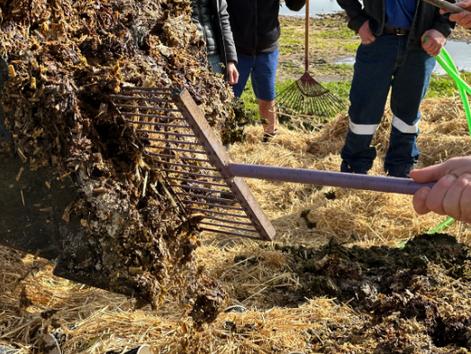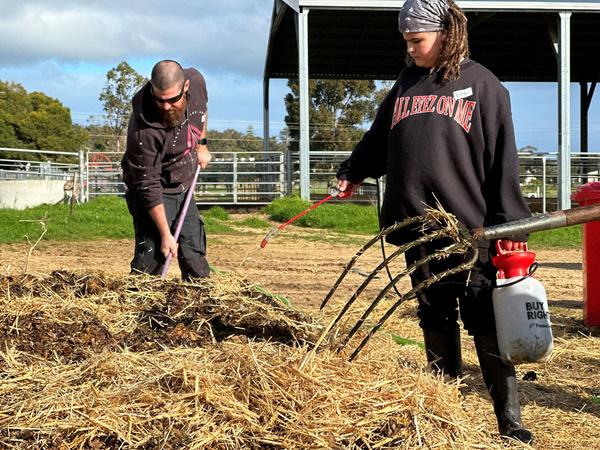




How to make simple, low labour & high-quality compost.
Composting essentially involves the use of certain practices and methods to manage decomposition and effectively turn organic residue into a valuable product that is used to benefit plant growth.
What you need to know about decomposition:
Decomposition is a naturally occurring process that is important for the health of terrestrial ecosystems
There are various populations of micro organisms that consume and incorporate the dead organic materials that end up on the surface of the soil
In the process:

The materials are broken down and inherent nutrients are liberated, making them available to be utilized by biology once again
Remaining organic matter is reduced to minute humus fractions that are all important for soil structure, moisture retention and nutrient holding capacity
Numerous biochemical compounds are produced by the various microbiological populations that stimulate surrounding biology, induce pest and disease resistance and promote plant growth
In natural environments, this is a gradual and ongoing process that is very much dependent on availability of materials and prevailing conditions.
Not All Compost Is Created Equal - Characteristics to look for when assessing the quality of compost include:
Smell: a pleasant earthy aroma
Colour: a dark, rich chocolate colour
Mature: well broken down without any recognisable parent material
Consistent: uniform in texture
Structure: light and crumbly
Bolus: can be moulded like soft putty

Australian Standard
Certified compost products must be within certain thresholds when it comes to things like chemical contaminants, plant propagules, pathogens, the occurrence of glass, metals, plastics and stones etc In order for compost to qualify and be branded for sale as a certified product it must comply with Australian Standard 4454
Space: is there enough space for stockpiling of materials and equipment
Access: can we get to and move around everything with ease
Proximity: is it close enough to feedstocks, equipment, paddocks or where you want to take it
Water: Is there a readily available source of water on hand
Drainage: is the site free from waterlogging
Protection: is it protected from the sun, wind and rain
Weeds and pests: are there problematic weeds or pests in the area that could impact operations
Neighbours: feedstock materials can be smelly and the movement of machinery is noisy so must be suitably distanced from neighbours
Surrounding Environment: nutrient rich runoff can negatively affect wetland systems and traffic may impact on sensitive wildlife
Regulations: each state has different regulations that need to be adhered to in WA land managers must follow the DWER Regulation
Guidelines
Equipment needed may include:
Pitchfork/shovel
Machinery - tractor, turner, mulcher
Garden hose/firefighting unit
Mixing buckets, backpack sprayer, watering can
Tarp, weedmat etc
Thermometer
Infrastructure - pallets, wire mesh etc
PPE - gloves, mask etc
Feedstocks are the raw ingredients needed to make your compost Some things you want to consider when sourcing feedstock materials are:
C:N ratios
Quality
Cost
Availability & Accessibility
Particulate size
Contamination - biological, physical, chemical
Diversity
Ease of Handling






To make compost well, we need to provide the microorganisms involved with a good balance of the food, air and water they require, and suitable living conditions.
To break it down further, the composting process is all about how we manage the following areas:
Feedstocks
Additives
Mixing
Pile Construction
Moisture Level
Aeration

Temperature control Protection
Carbon based materials provide the energy that fuels microbial activity
Sources include woodchips, prunings, clippings, crop residue, shredded newspaper, bran etc
Nitrogen rich materials are integral for building the protein required by microbial biomass Sources include manure, animal matter, blood and bone, legumes etc
Fresh plant and animal materials, while not essential, bring a range of active microbes, vitamins, hormones and enzymes that contribute to the overall diversity and health of the biology in the compost heap. Sources include greens, fresh pruning's, weeds, grass clippings, crop waste, seaweed etc
Additives can be included along with bulk foodstocks, when making compost, that have qualities known to enhance favourable characteristics of compost . These include things like:
Rock Minerals
Calcium Sources
Trace Elements
Ash
Diatomaceous Earth
Biochar
Bonemeal
Zeolite
Inoculants
Clay (powder)
Seaweed (liquid or powder)
Zeolite
Inoculants
Seaweed (liquid or powder)
Generally speaking, 50-60% carbon-based materials, 10-20% nitrogen rich materials and 20-30% green plant materials by volume and 5-10% additives by weight are reliable ratios to work with
A good visual analogy for quantities of different types of ingredients to use in compost is a pasta dish On your plate you generally have a decent amount of spaghetti (carbon based ingredients), with some pasta sauce topping (nitrogen rich ingredients), a side salad (fresh plant materials) and a sprinkling of salt and pepper (additives)





When assembling a compost heap it is important that the different types of materials are either layered in repeated sequences and/or mixed well beforehand so that microbes have ready and even access all the feedstocks This makes for a homogenous product in a shorter time frame
Adequate material bulk is necessary if you want to create thermophilic conditions However, if piles are too high, it is prone to getting too hot and lower layers may compact With such composting, an appropriate height would be in the vicinity of 1.2-1.5m. Bulk volume is achieved with succinct stacking of rows or piles or the use of a bay or cage to contain the materials.
Protection:
Exposure to extreme weather can be problematic so it may best to set up your compost in a somewhat sheltered spot
Providing a semi permeable (to allow for gas exchange) protective covering reduces evaporative water loss and generally helps to regulate conditions within the heap, making for more uniform decomposition
Water:
When making compost, dry ingredients should be wetted, and throughout the life of a heap, moisture levels must be monitored and maintained to prevent it from drying out
Some micro-organisms and worms, don’t fare so well in hard / saline / chlorinated water If you’re going to get serious about making compost it might be worth checking your water quality



Air:
If oxygen is not replenished as fast as it is used, the inherent oxygen quota can be exhausted, creating less favourable, anaerobic conditions This is most likely to occur with larger volumes of, or compacted, material as movement of air to the inside of the heap is somewhat restricted Compost can be systematically turned during this phase to maintain oxygen levels
Temperature:
When a compost heap is assembled, it doesn’t take long for things to hot up to what is referred to as thermophilic conditions (>50C)
If sufficient heat is generated, undesirable pathogens and weed seeds are destroyed All material needs to have been maintained above 55C for a minimum of three days to achieve this sterilisation standard However, at temperatures above 65C, many beneficial microbes are destroyed
Over the maturation phase (<40C), a broad community of microbes slowly decompose - strong fungal colonisation is possible at this stage and disturbance should be minimised
At below 30C composting worms can be introduced to the heap




In each phase of composting, specific substrate components are degraded and a varying product quality is achieved
Mesophilic Phase: Acid- forming bacteria and sugar-utilising fungi
Thermophilic phase: a species change takes place to a less broad range of thermophilic bacteria and actino- bacteria and only a couple of thermophilic fungi
Maturation Phase: fungi in particular prevail; as they are adapted to the substrate components which are less degradable and to the substrate humidity that tends to be lower
Regardless of the chosen method, in many ways the art of making good compost lies in our ability to manage these different stages of decomposition so that the various microbe groups can do their thing and turnover a quality product.
Aerobic Thermal:
Involves routine monitoring and systematically turning the heap in accordance with temperature and duration thresholds
A standard recommendation is to turn within three days at temperatures between 55-60C, turn within 48 hours at between 60-65C and turn immediately if above 65C
Static Aerated:
Involves a structural component that enables good airflow to replenish the oxygen used by respiring microbes during the more active phases of decomposition
Oxygenation and temperature are self-regulated, therefore these systems don’t require any turning
Contrary to common compost practice, airflow in fermentation systems is purposely restricted, and moisture is maintained at higher levels
Materials are normally wetted, inoculated with a starter culture, combined, and then contained or covered to restrict the supply of oxygen
Vermiculture
The principle behind continuous feed vermiculture systems is that you onl add smaller amounts of feedstock material at a time to keep them from getting too hot for worms
Alternatively, larger amounts of material can be partially composted first get past the thermophillic phase before worms are added





Target applications to benefit plant growth for the subsequent benefits that come from having heathy plants in the system
Using compost, and slurries/extracts of, at planting to coat seeds, for in furrow liquid applications or as a seedling dip is very economical as only small amounts are required to aid the establishment of a healthy plant microbe biome from the start
We can stimulate microbial activity and boost populations with the addition of biostimulants and foods prior to application
Compost can be mixed and applied with water to improve distribution, coverage and infiltration
The timing and placement and method of application can be targeted to maximise efficiency and/or tailored to desired outcomes
Some fertilisers can be mixed and applied with compost to improve availability, uptake and stability


It is best to carry out compost applications in favourable conditions and avoid extreme weather events to prevent loss of or compromise qualities of the applied product
Compost is generally used to improve:
biological activity
plant nutrition
pest and disease resistance
Compost Application Rates:
soil structure
nutrient and water holding capacity







Guidelines are downloadable via the full online article
‘On Farm Composting’ To access please go to https://lower-blackwoodshorthandstoriescom/onfarm-composting/indexhtml
This document is a downloadable summary of the online article & content hub ‘On Farm Composting’. The article was produced by 'Talkin' After Hours', the Lower Blackwood Landcare's Online Community & Information Hub, and written & collated by Mark Tupman from Productive Ecology The aim of the article is to assist land managers to build their knowledge and skills to make and use compost


The development of this article was funded through Soil Wise Soil Wise is funded by the National Landcare Program Smart Farms Small Grants – an Australian Government initiative. It is supported by Healthy Estuaries WA – a State Government program

